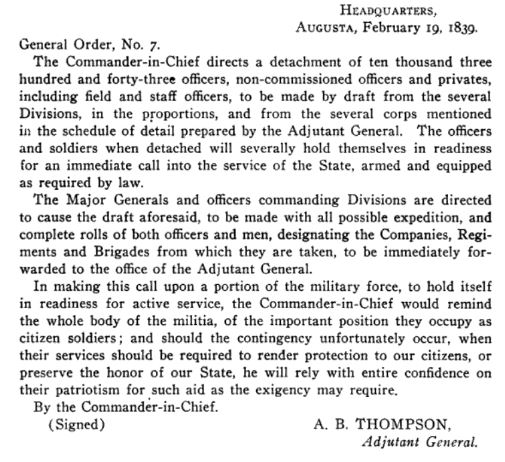The Aroostook War
The Aroostook War of 1839 was the first military crisis in which Maine was engaged as a state. Though a bloodless war, the militia was called and prepared for battle. The following account is taken directly from the 1939 National Guard of the United States, State of Maine yearbook.
In June, 1837, Congress sent an officer to Madawaska to make a census of the people. A British constable arrested this agent and carried him to the nearest English shire town, but the sheriff there refused to receive the prisoner, who returned to Madawaska and continued his duties.
Governor Harvey of New Brunswick, thinking an effort was being made to induce the inhabitants to continue their allegiance to the United States, ordered the agent to be re-arrested and he was lodged in Frederickton jail. Governor Dunlap of Maine issued a general order, announcing that the soil of our State had been invaded by a foreign power and ordering the militia to hold themselves in readiness for active duty. A few weeks later the British authorities freed the imprisoned agent.
In 1838, Governor Kent of Maine, to increase the efficiency of the militia, sent General Wood to inspect its fortifications on the Penobscot, the St. Croix and the Kennebec. The line which Maine claimed buy the treaty of 1783 was again surveyed. The territory thus in dispute became the prey of plunderers. Soon there was conflict between the British lumbermen and American officials.
Governor Harvey of New Brunswick issued a proclamation, declaring that British territory had been invaded and ordering out 1,000 men of the militia. Affairs now began to look serious. Immediately 50 volunteers from Augusta were on their way to the scene of action.

At the same time, Governor Harvey sent a communication to the Governor of Maine, demanding the recall of American troops from the Aroostook, announcing that he was instructed by the British government to hold exclusive charge over the disputed territory and that he should do so by military force. This aroused the indignation of the people of Maine. The legislature passed a resolve for the protection of public lands and appropriated $800,000 for that purpose. A draft was also ordered for 10,343 men from the militia to be ready for immediate duty. Within a week, thousands of Maine militia were either in Aroostook County or on the march there.
Congress passed a bill authorizing the President to raise 50,000 troops for the support of Maine, and appropriating ten million dollars to meet the expense, should the Governor of New Brunswick fulfill his threat of maintaining exclusive jurisdiction over the territory in dispute.
On March 5, 1839, General Scott, with his staff, arrived in Augusta. He informed the Governor that "He was specially charged with maintaining the peace and safety of the entire northern and eastern frontiers." He established headquarters at the Augusta House and entered into correspondence with both Governor Harvey of New Brunswick and Governor Fairfield of Maine, endeavoring to act the part of peacemaker.
Although the Aroostook War called for troops, sent to the scene of disturbance, the outbreak was a bloodless one. During April and May, 1839, the militia troops were withdrawn from Aroostook County, mustered out, and returned home. Great Britain continued to be the feared enemy during the 1840s, which prompted the building of Fort Knox, the largest fort in Maine.